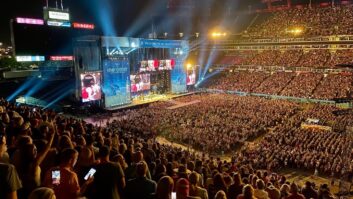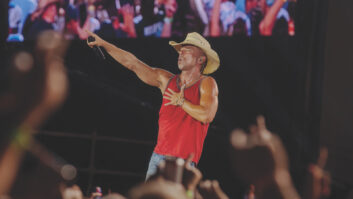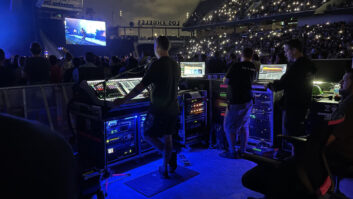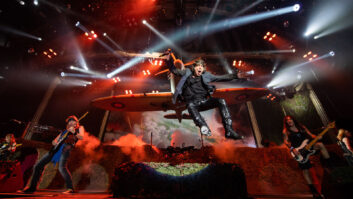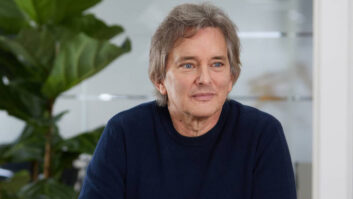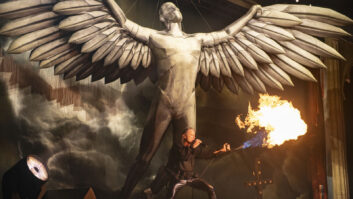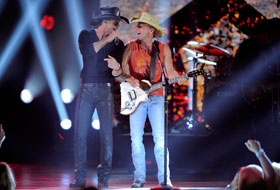
Tim McGraw and Kenny Chesney
Photo: AP/Mark J. Terrill
Kicking off June 2 at the Raymond James Stadium in Tampa, Fla., Kenny Chesney and Tim McGraw’s Brothers of the Sun tour will play to more than a million and a half fans in 22 stadium shows over the course of this summer.
In addition to music from his extensive catalog, Chesney and his band are debuting their newest release Welcome to the Fishbowl (BNA Records), including the hits “Come Over” and “Feel Like a Rock Star,” the duet with McGraw. It’s a huge undertaking, boasting state-of-the-art P.A. and video, special guests Grace Potter & The Nocturnals and Jake Owen, and an encore that promises to rock the house.
A tour of this magnitude has serious audio responsibilities, being expertly handled by Bryan Vasquez (front of house), Phill “SidePhill” Robinson (monitors for Chesney and guests) and Bryan “Opie” Baxley (monitors for Chesney’s band). Lights, staging and P.A. are provided by Morris Light and Sound (Murfreesboro, Tenn.), and each of the three engineers is using a Midas PRO9 digital desk to handle approximately 60 inputs from the stage. Front-of-house P.A. is an Electro-Voice X-Line with XLC boxes for the delay system.
Vasquez—Chesney’s FOH engineer for the past 12 years—explains the nature of this particular tour: “We’ve done stadiums in the past, but these are back-to-back Saturdays and Sundays. We’ll roll in Friday morning for a normal stadium load-in, giving us the option of a soundcheck on Friday night. But after the show on Saturday we head for the next city, and that puts a squeeze on us. We won’t have time for soundchecks before the Sunday shows. It’s going to be run-and-gun. In order to make this work, we have two separate rigging packages out, plus some redundant peripheral gear like snakes to front of house. So we can roll in the second day with the P.A. and the lighting rig, fly it, set up the consoles and band gear and do the show.”
Chesney and his entire band are using in-ears. Drummer Sean Paddock and keyboardist Wyatt Beard have their own mixers onstage, while the rest of the band use Sennheiser 2000 Series wireless systems, with JH Audio JH16 Pro earpieces. Chesney is using the Shure PSM 1000 ear system, also with JH Audio JH16 Pros.
Supplementing the ear mixes are wedges (Nexo 45 N-12 arrayable line monitors) and fill speakers. Baxley creates “seven stereo ear mixes for Kenny’s band, but each one of those mixes also has a wedge for low end and fill, and we have sidefills for the guys downstage. We started rehearsals with just the ears, and once we got the mixes comfortable for each musician, we added what they felt was missing in the wedges and fill speakers. The ears do reproduce those frequencies, down to around 50 Hz, but you miss the feel factor, that air movement that you get in a live setting where there are a lot of wedges or where it’s a smaller stage. There’s a lot of separation between each guy on such a big stage.”

From left: Phill Robinson, Bryan Vasquez and Bryan Baxley
Photo: Jill Trunnell
Robinson concurs, saying, “The fills and wedges help keep up the energy onstage. When we started doing bigger shows three or four years ago, we built a ‘T’ out to the audience, and it was simply not possible to carefully watch both the band and Kenny while Kenny was out on the T. That’s why we split up the monitor mixes. When Kenny’s in front of the proscenium in the sound field of a 60-cabinet P.A. system we have to make sure that the energy stays the same and that there’s no feedback. The start of the show is a little nerve-wracking because Kenny flies in from front of house on a rig that puts him 12 feet above the crowd, directly in front of the P.A. With a giant P.A. that can fill a stadium, it gets interesting some days to make it loud enough without feedback.”
“As Kenny flies around,” Vasquez adds, “I’ll pan his vocal very slightly to the left as he is in front of the right side of the P.A. and vice versa. After working with Kenny for 12 years, I’m able to kind of anticipate problems before they happen.”

Photo: Jill Trunnell
Chesney’s vocal microphone is a Shure Axient AXT200 wireless transmitter with a KSM9HS capsule, set to hypercardioid. According to Vasquez, “Kenny likes to cup his hand around the capsule of his vocal microphone. The amazing thing about this Shure is you don’t get that change in tonality, or the feedback, that you get with other microphones when cupped. There’s no outboard processing whatsoever—I just use the preamp in the Pro9, and I try to use as little compression as possible so I can let it breathe.”
It may come as a bit of a surprise that all three engineers use minimal processing, almost all of which is onboard the Pro9s. Baxley says that he uses one of the Pro9’s onboard Klark Teknik reverbs in an unconventional manner for the top snare drum microphone: “You know how you can dial in the LF or HF on the reverb? We’re actually using that on the snare top mic to get a little bit more 250 Hz out of the snare—we’re doing it with the reverb, not the EQ. I have the reverb inserted on that channel and I use the dry/wet mix to make sure that the level of the snare is the same whether the insert is in or out. It sounds crazy that I am using a time-based processor on an insert, but it works.”
Baxley also notes that he does not use gates on the drum mics because Paddock plays brushes in one or two spots and likes to be able to back his dynamics way down without worry that he’ll hear gates popping in and out. Mics for the drum kit include Audio-Technica AE5100 for hat and ride, ATM650 for snare bottom, AT4081 ribbons for overheads (“They sound like you’re standing next to the kit,” states Baxley), Heil PR28 for toms, Shure SM57 for snare top, and Shure Beta 52 and Yamaha SubKick on the kick drum.
Vasquez notes that some of the guitar amps are “placed offstage and some of the guys have cabinets behind them. The offstage cabinets are placed inside big foam-lined boxes with Shure SM57s—30 years and still working! Bassist Steve Marshall has an 8×10 cab onstage, but I take my signal from the balanced line output of an Avalon Vt-737, and he uses the other output for his rig. I don’t mike the cabinet, it’s just the Avalon.”

Photo: AP/Mark J. Terrill
You Can Leave Yer’ Hat On
According to Robinson, Chesney’s main requirements for his ear mix are “clarity, a lot of vocal and some reverb. I have a [Yamaha] REV5 stuck at the bottom of the rack as a comfort from the ‘old world’ for Kenny’s vocal. It’s a ’verb I can adjust on the fly without need for a menu.” (In Robinson’s absence, Baxley quips, “I think that Phill has been using that thing for almost 14, 15 years now. He is married to that reverb. If it goes down, he’s screwed!”)
“During soundcheck,” continues Robinson, “I’ll wear my baseball hat because the timbre of the mic can change depending on the type of hat Kenny wears. His main hats are a straw cowboy hat that doesn’t give me any problems, but he also has a black cowboy hat that is stiffer and more reflective. When you have 75,000 people screaming at your head, all that sound is coming up, hitting that hat and bouncing back into the mic.”
Put Me on The Guest List, Plus 8
Although Chesney and McGraw have toured together previously, this one is unique due to the encore. All members of both bands take the stage. Luckily for the three engineers, that doesn’t mean the number of inputs from the stage is doubled. As Vasquez explains, “In Kenny’s band we have three main guitar players: Clayton Mitchell [lead], Kenny Greenberg [rhythm] and Jon Conley, who doubles on guitar and fiddle. Jim Bob Gairrett is our steel guitar player who also plays acoustic guitar on some songs. Some of the guys have more than one guitar rig. For example, Clayton plays a stereo rig, and a mono dry rig, all miked with SM57s, but I leave the channels up all the time. He has the ability to go back and forth as he chooses and they’ll always be there. This means that some of the inputs for the guests are already in place from Kenny’s band, which makes things a bit more manageable.”
“Tim’s band is sharing much of our instrumentation,” Baxley elaborates, “because most of our guys have separate rigs coming through two channels—for example, one for a Strat and another for a Les Paul. So if my guy is playing the Strat for a song, then the guest will take up his Les Paul rig. The monitor mixes for the guest players are run from Phill’s desk because he has open mixes. It’s just a few more channels.”
At this point in the show, Robinson and McGraw’s monitor engineer, Jonny B, are tag-teaming, working together to create 11 more wireless ear mixes from the same Pro9. All those ear mixes—combined with wireless vocal mics for Chesney and McGraw and the wireless instrument systems—yield a significant amount of RF activity. Since the DTV reorganization, Baxley has noticed “smaller and smaller gaps for us to fit in our wireless channels, especially when we get to bigger cities. For example, out in the Meadowlands [New Jersey], there are a lot of TV and cell towers. You fire it up and it’s a bit of a headache. Stadiums like that where there’s a lot of TV coverage sometimes have a wireless coordinator who might come in on our first day and help us find some holes for our systems, but we’re usually self-sufficient.”
“Terry Fox is our keyboard tech and general fix-it guy,” Robinson adds. “He has a wireless workbench in his world and I have a wireless scanner in my world, so together we figure out what everybody needs and set up frequencies.”
Vasquez, Baxley and Robinson all agree that one of the big challenges of this tour is maintaining consistency night to night. The tour carries a mic package, but Baxley says they “take it a step further and use the same microphone on the same instrument every night. For example, we have four identical Heil PR28 mics for the toms, but we’ll make sure that the same mic is used for the same drum each night. It sounds a little crazy, but we want it consistent throughout the whole tour.
“On the days we don’t get a soundcheck, the band is really relying on us to get it right during line check. They’ll only have about five minutes to tinker between Tim tearing down and our video rolling to start our portion of the show. They’ll never play as a band until the first song starts on Sunday.”
Nerve-wracking indeed!
Steve La Cerra is Mix magazine’s Sound Reinforcement Editor and mixes front of house for Blue Öyster Cult.
